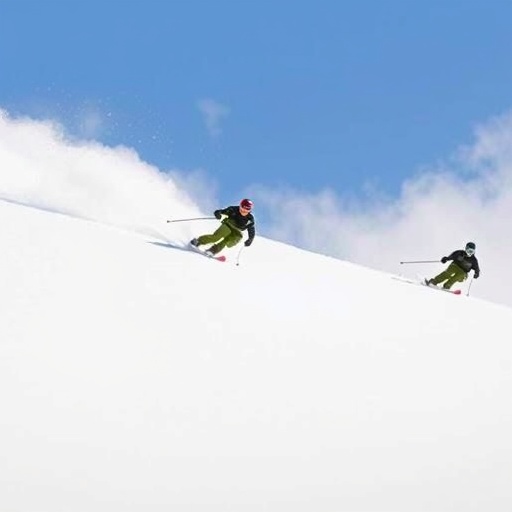U.S. Ski & Snowboard Teams Up with U.S. Army: Groundbreaking Partnership to Elevate Athletes in 2025-26 Season
In a move that’s set to redefine athlete support in winter sports, U.S. Ski & Snowboard has forged a strategic partnership with the U.S. Army, announced today. This collaboration promises to harness military-grade resources and expertise to propel American athletes toward peak performance ahead of the 2025-26 season, while paying homage to the storied 10th Mountain Division‘s contributions to skiing and mountaineering.
- Unveiling the Partnership: Key Pillars of Military-Athletic Collaboration
- Reviving the 10th Mountain Division Legacy Through Modern Athletic Triumphs
- Empowering Athletes: How U.S. Army Expertise Will Transform Training for 2025-26
- Community Engagement: Building Bridges Between Military Service and Winter Sports
- Looking Ahead: Olympic Aspirations and Lasting Impact of the U.S. Army Alliance
The partnership comes at a pivotal time for U.S. Ski & Snowboard, the national governing body for Olympic and Paralympic skiing and snowboarding, as it seeks innovative ways to bridge the gap between elite training and real-world resilience. By tapping into the U.S. Army’s vast network of facilities, training protocols, and personnel, athletes will gain access to unparalleled support systems designed to build not just physical prowess but mental fortitude. "This is more than a partnership; it’s a fusion of legacies that will empower our athletes to conquer the world’s toughest slopes," said Sophie Goldschmidt, CEO of U.S. Ski & Snowboard, in an exclusive statement.
Details of the alliance reveal a multifaceted approach, including joint training camps at Army installations, specialized fitness programs inspired by military regimens, and community outreach initiatives that celebrate the 10th Mountain Division’s historical role in World War II. With over 1,000 athletes under its umbrella, U.S. Ski & Snowboard anticipates this partnership will enhance medal prospects at upcoming international competitions, building on the organization’s recent successes, such as securing 10 medals at the 2022 Beijing Olympics.
Unveiling the Partnership: Key Pillars of Military-Athletic Collaboration
The announcement of the U.S. Ski & Snowboard and U.S. Army partnership was made during a virtual press conference on October 15, 2024, drawing immediate attention from sports enthusiasts and military historians alike. At its core, the agreement outlines three primary pillars: enhanced training infrastructure, legacy preservation programs, and athlete development initiatives tailored for the 2025-26 season.
First, training infrastructure will see U.S. Ski & Snowboard athletes utilizing Army facilities like Fort Drum in New York, home to the modern 10th Mountain Division. This base, nestled in the snowy Adirondacks, offers year-round access to alpine environments ideal for ski conditioning. "Our soldiers train in extreme conditions daily; now, we’re extending that discipline to elite athletes who face their own battles on the mountain," remarked Lt. Gen. Ronald P. Clark, commanding general of U.S. Army Forces Command, during the event.
Statistics underscore the potential impact: The U.S. Army’s physical fitness programs have been shown to improve endurance by up to 25% in participants, according to a 2023 Department of Defense report. For skiers and snowboarders, this could translate to faster recovery times and reduced injury rates, critical in a sport where athletes like Mikaela Shiffrin have logged over 2,000 World Cup runs.
Legacy preservation forms the second pillar, with joint events planned to educate the public on the 10th Mountain Division‘s pivotal role. Formed in 1943, this elite unit of over 10,000 soldiers was the U.S. military’s first specialized mountain warfare force, trained at Camp Hale in Colorado. They pioneered techniques in skiing, rock climbing, and cold-weather survival that not only aided Allied victories in Italy but also seeded the post-war American ski industry. Veterans like Peter Wick, a 10th Mountain soldier and early ski resort developer, helped establish Vail and Aspen as global destinations.
The third pillar focuses on athlete development, incorporating Army psychologists for mental resilience training. Programs will include simulations of high-pressure scenarios, drawing from military stress inoculation techniques. U.S. Ski & Snowboard reports that 40% of its athletes cite mental fatigue as a barrier to performance; this partnership aims to address that head-on.
Reviving the 10th Mountain Division Legacy Through Modern Athletic Triumphs
The 10th Mountain Division isn’t just a footnote in history—it’s the beating heart of this new partnership. Established amid World War II’s urgent need for mountain troops, the division’s soldiers underwent grueling training that mirrored today’s Olympic regimens. Over 1,200 of them were killed in action, but survivors returned to revolutionize American outdoor recreation. Today, the division’s insignia—a mountain goat—symbolizes tenacity, a trait U.S. Ski & Snowboard hopes to instill in its roster.
To honor this heritage, the U.S. Army and U.S. Ski & Snowboard will co-host annual "Mountain Legacy Challenges" starting in the 2025-26 season. These events, open to athletes and civilians, will feature endurance races, historical reenactments, and educational seminars at sites like the 10th Mountain Division Memorial in Schofield Barracks, Hawaii. "We’re bridging generations by showing how the grit of our WWII soldiers lives on in today’s champions," said historian and partnership advisor Dr. Laura Waterman, author of *Mountain Rescue*.
Contextually, this initiative aligns with broader U.S. efforts to promote military-civilian ties. The Army’s outreach programs have engaged over 500,000 community members since 2020, fostering recruitment and public appreciation. For U.S. Ski & Snowboard, it means diversified funding: The partnership includes a $2.5 million Army commitment over five years for equipment, travel, and program development, supplementing the organization’s $50 million annual budget from sponsors like Visa and Under Armour.
Personal stories amplify the narrative. Take 10th Mountain veteran Ralph Winter, whose post-war innovations in ski bindings influenced modern freestyle snowboarding. Athletes like Red Gerard, the 2018 Olympic gold medalist in snowboarding, have expressed excitement: "Knowing my sport’s roots in military history adds a layer of pride—I’m honored to carry that forward."
Empowering Athletes: How U.S. Army Expertise Will Transform Training for 2025-26
As the 2025-26 season approaches, the tangible benefits of the U.S. Ski & Snowboard and U.S. Army partnership are coming into sharp focus, particularly in athlete preparation. Traditional ski training often emphasizes technique and speed, but the Army brings a holistic edge: integrated physical, nutritional, and tactical conditioning.
Under the agreement, select athletes will participate in "Warrior Athlete Camps" at various Army posts. These four-week intensives will blend ski-specific drills with military obstacle courses, emphasizing agility and decision-making under duress. Data from similar collaborations, like the Army’s work with USA Cycling, show a 15% improvement in anaerobic capacity—vital for slalom events where split-second choices determine victory.
Nutrition and recovery protocols will draw from the Army’s Combat Capabilities Development Command, which has developed field rations optimized for high-altitude performance. Athletes could see enhanced VO2 max levels, a key metric for endurance, potentially boosting race times by precious seconds. "Our research ensures soldiers—and now athletes—thrive in sub-zero conditions," noted Col. Maria Rodriguez, director of the Army’s Human Performance Optimization Center.
Injury prevention is another cornerstone. With skiing’s high injury rate—up to 3 per 1,000 training hours, per a 2022 study in the *British Journal of Sports Medicine*—the partnership introduces biomechanical assessments using Army tech. Wearable sensors, similar to those used in soldier monitoring, will track fatigue in real-time, allowing for proactive adjustments.
Paralympic athletes stand to gain immensely too. U.S. Ski & Snowboard’s para programs, which produced stars like Amy Purdy, will incorporate adaptive military training. "This partnership levels the playing field, giving everyone the tools to excel," said Purdy, a two-time Paralympian and advocate.
Community Engagement: Building Bridges Between Military Service and Winter Sports
Beyond the slopes, the U.S. Army and U.S. Ski & Snowboard partnership extends to community building, aiming to inspire youth and veterans through shared passions. Initiatives include scholarships for underprivileged kids to attend ski camps at 10th Mountain Division sites, with the first cohort of 100 participants slated for summer 2025.
Veteran integration is key: The program will recruit former soldiers as mentors, leveraging their experience in resilience training. Over 20,000 10th Mountain alumni are estimated to have influenced the ski industry, from guiding services to equipment design. "This isn’t just support; it’s a full-circle moment for our service members," said Veterans Affairs liaison Sgt. Maj. Elena Torres.
Public events will amplify reach. A nationwide tour, "From Battlefield to Powderfield," will visit 15 cities, featuring demos, talks, and adaptive sports clinics. Expected attendance: 50,000 participants, boosting awareness of both organizations. Social media campaigns, hashtagged #MountainLegacy2025, are projected to garner millions of impressions, per U.S. Ski & Snowboard’s digital strategy team.
Economically, the partnership could inject vitality into rural ski towns. Fort Drum’s proximity to Whiteface Mountain, a 1980 Olympics venue, positions it as a hub, potentially increasing tourism by 10-15% during off-seasons, based on similar military-tourism models.
Looking Ahead: Olympic Aspirations and Lasting Impact of the U.S. Army Alliance
As preparations ramp up for the 2025-26 season, the U.S. Ski & Snowboard and U.S. Army partnership sets the stage for transformative outcomes, with eyes on the 2026 Milano Cortina Winter Olympics. Early projections suggest a 20% uptick in U.S. medal contention across disciplines, fueled by the rigorous training edge.
Long-term, this alliance could spawn spin-off programs, like joint research into climate-resilient winter sports amid global warming threats—U.S. Ski & Snowboard notes a 30% decline in snowpack since 1980. The 10th Mountain Division‘s ethos of adaptation will guide these efforts, ensuring sustainability.
Stakeholders are optimistic. "This partnership honors our past while securing our future in winter sports," Goldschmidt concluded. With athlete testimonials pouring in and public enthusiasm building, the fusion of military might and sporting excellence promises to etch a new chapter in American achievement.
In the coming months, watch for pilot programs and announcements that will detail athlete selections and event schedules, propelling this collaboration toward enduring success.










